 |
 |
Our enthusiastic and extremely knowledgeable perennials team is here to answer your questions and help you choose the best perennials for your situation. There’s always something in bloom for sun, shade, butterflies, birds or deer resistance as well as a variety of bulbs for your space.
Stroll through our time-tested favorites and introduce yourself to the newest varieties. We garden with perennials too; we love them and it shows!
|
251 found, showing page 6 of 17

Ruffled petals with sunset pink and coral tones. Black walnut tolerant. USDA 3-9
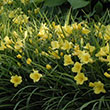
Plant Height: 12 inches
Flower Height: 18 inches
Spacing: 14 inches
Sunlight: full sun, partial shade
Hardiness Zone: 2b
Group/Class: Happy Ever Appster Series
Description:
Lightly ruffled, soft yellow blooms make an appearance in late spring and rebloom during the summer season; a beautiful contrast to green strappy foliage, perfect for borders, beds and patio containers; an easy to grow and low maintenance series
Ornamental Features:
Happy Ever Appster Happy Returns Daylily features bold yellow trumpet-shaped flowers at the ends of the stems from late spring to late summer. The flowers are excellent for cutting. Its grassy leaves remain green in color throughout the season.
Landscape Attributes:
Happy Ever Appster Happy Returns Daylily is an herbaceous perennial with a shapely form and gracefully arching foliage. It brings an extremely fine and delicate texture to the garden composition and should be used to full effect.
This is a relatively low maintenance plant, and is best cleaned up in early spring before it resumes active growth for the season. It is a good choice for attracting butterflies to your yard. It has no significant negative characteristics.
Happy Ever Appster Happy Returns Daylily is recommended for the following landscape applications:
- Mass Planting
- Border Edging
- General Garden Use
- Groundcover
- Container Planting
Planting & Growing:
Happy Ever Appster Happy Returns Daylily will grow to be about 12 inches tall at maturity extending to 18 inches tall with the flowers, with a spread of 18 inches. When grown in masses or used as a bedding plant, individual plants should be spaced approximately 14 inches apart. Its foliage tends to remain dense right to the ground, not requiring facer plants in front. It grows at a medium rate, and under ideal conditions can be expected to live for approximately 10 years. As an herbaceous perennial, this plant will usually die back to the crown each winter, and will regrow from the base each spring. Be careful not to disturb the crown in late winter when it may not be readily seen!
This plant does best in full sun to partial shade. It is very adaptable to both dry and moist locations, and should do just fine under typical garden conditions. It is not particular as to soil type or pH. It is highly tolerant of urban pollution and will even thrive in inner city environments. This particular variety is an interspecific hybrid. It can be propagated by division; however, as a cultivated variety, be aware that it may be subject to certain restrictions or prohibitions on propagation.
Happy Ever Appster Happy Returns Daylily is a fine choice for the garden, but it is also a good selection for planting in outdoor pots and containers. It is often used as a 'filler' in the 'spiller-thriller-filler' container combination, providing a mass of flowers against which the thriller plants stand out. Note that when growing plants in outdoor containers and baskets, they may require more frequent waterings than they would in the yard or garden.
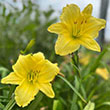
Plant Height: 12 inches
Flower Height: 18 inches
Spacing: 18 inches
Sunlight: full sun, partial shade
Hardiness Zone: 2b
Group/Class: Happy Ever Appster Series
Description:
Everblooming, soft lemon-yellow trumpets with green throat and ruffled edges; sturdy, strong, easy to care for, great grassy texture and form; good for the beginner gardener and the pro
Ornamental Features:
Happy Ever Appster Big Time Happy Daylily features bold lemon yellow trumpet-shaped flowers with green throats at the ends of the stems from early summer to mid fall. The flowers are excellent for cutting. Its grassy leaves remain green in color throughout the season.
Landscape Attributes:
Happy Ever Appster Big Time Happy Daylily is an herbaceous perennial with a shapely form and gracefully arching foliage. It brings an extremely fine and delicate texture to the garden composition and should be used to full effect.
This is a relatively low maintenance plant, and is best cleaned up in early spring before it resumes active growth for the season. It is a good choice for attracting butterflies to your yard. It has no significant negative characteristics.
Happy Ever Appster Big Time Happy Daylily is recommended for the following landscape applications:
- Mass Planting
- General Garden Use
- Groundcover
Planting & Growing:
Happy Ever Appster Big Time Happy Daylily will grow to be about 12 inches tall at maturity extending to 18 inches tall with the flowers, with a spread of 24 inches. When grown in masses or used as a bedding plant, individual plants should be spaced approximately 18 inches apart. Its foliage tends to remain dense right to the ground, not requiring facer plants in front. It grows at a medium rate, and under ideal conditions can be expected to live for approximately 10 years. As an herbaceous perennial, this plant will usually die back to the crown each winter, and will regrow from the base each spring. Be careful not to disturb the crown in late winter when it may not be readily seen!
This plant does best in full sun to partial shade. It is very adaptable to both dry and moist locations, and should do just fine under typical garden conditions. It is not particular as to soil type or pH. It is highly tolerant of urban pollution and will even thrive in inner city environments. This particular variety is an interspecific hybrid. It can be propagated by division; however, as a cultivated variety, be aware that it may be subject to certain restrictions or prohibitions on propagation.
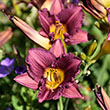
Ruffled purple blooms with yellow throats. Rebloomer. USDA 3-9
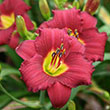
Plant Height: 12 inches
Flower Height: 18 inches
Spacing: 14 inches
Sunlight: full sun, partial shade
Hardiness Zone: 2b
Description:
A reblooming variety with a compact, vigorous habit; fragrant, ruffled burgundy flowers with chartreuse-gold throats rise above mounds of arching green foliage; an elegant addition to borders, beds and containers; low maintenance and easy to grow
Ornamental Features:
Pardon Me Daylily features bold fragrant burgundy trumpet-shaped flowers with chartreuse throats at the ends of the stems from early to late summer. The flowers are excellent for cutting. Its grassy leaves remain green in color throughout the season.
Landscape Attributes:
Pardon Me Daylily is an herbaceous perennial with tall flower stalks held atop a low mound of foliage. It brings an extremely fine and delicate texture to the garden composition and should be used to full effect.
This is a relatively low maintenance plant, and is best cleaned up in early spring before it resumes active growth for the season. It is a good choice for attracting butterflies to your yard. It has no significant negative characteristics.
Pardon Me Daylily is recommended for the following landscape applications:
- Mass Planting
- Border Edging
- General Garden Use
- Groundcover
- Container Planting
Planting & Growing:
Pardon Me Daylily will grow to be about 12 inches tall at maturity extending to 18 inches tall with the flowers, with a spread of 18 inches. When grown in masses or used as a bedding plant, individual plants should be spaced approximately 14 inches apart. Its foliage tends to remain dense right to the ground, not requiring facer plants in front. It grows at a medium rate, and under ideal conditions can be expected to live for approximately 10 years. As an herbaceous perennial, this plant will usually die back to the crown each winter, and will regrow from the base each spring. Be careful not to disturb the crown in late winter when it may not be readily seen!
This plant does best in full sun to partial shade. It is very adaptable to both dry and moist locations, and should do just fine under typical garden conditions. It is not particular as to soil type or pH. It is highly tolerant of urban pollution and will even thrive in inner city environments. This particular variety is an interspecific hybrid. It can be propagated by division; however, as a cultivated variety, be aware that it may be subject to certain restrictions or prohibitions on propagation.
Pardon Me Daylily is a fine choice for the garden, but it is also a good selection for planting in outdoor pots and containers. It is often used as a 'filler' in the 'spiller-thriller-filler' container combination, providing a mass of flowers against which the larger thriller plants stand out. Note that when growing plants in outdoor containers and baskets, they may require more frequent waterings than they would in the yard or garden.
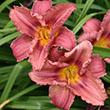
Rosy Returns Daylily | Dark, pinkish-red blooms have golden-yellow throats. Early season bloomer USDA 3-9
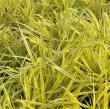
Golden Hakone Grass | Gracefully arching green leaves variegated with gold striping. Yellow-green flowers appear in loose, nodding panicles in mid-summer. Naturalizing. USDA 5-9
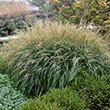
'Adagio' Maiden Grass | Pinkish blooms. Upright clumping grass. Self-seeding. USDA 5-9
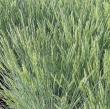
Height: 8 inches
Spread: 12 inches
Sunlight: full sun, partial shade
Hardiness Zone: 2b
Other Names: Festuca ovina var. glauca
Description:
A dwarf ornamental grass featuring bright silver-blue foliage; neat mounds of densely tufted leaves stay blue all season long; tall upright tan plumes sway in the breeze; drought tolerant once established, great for containers, beds and borders
Ornamental Features:
Elijah Blue Fescue is primarily valued in the garden for its interestingly mounded form. Its attractive grassy leaves remain blue in color throughout the year. The tan seed heads are carried on spikes from mid summer to late fall.
Landscape Attributes:
Elijah Blue Fescue is an herbaceous evergreen perennial grass with a mounded form. It brings an extremely fine and delicate texture to the garden composition and should be used to full effect.
This is a relatively low maintenance plant, and is best cleaned up in early spring before it resumes active growth for the season. It has no significant negative characteristics.
Elijah Blue Fescue is recommended for the following landscape applications:
- Rock/Alpine Gardens
- Border Edging
- General Garden Use
- Naturalizing And Woodland Gardens
- Container Planting
Planting & Growing:
Elijah Blue Fescue will grow to be about 8 inches tall at maturity, with a spread of 12 inches. Its foliage tends to remain low and dense right to the ground. It grows at a medium rate, and under ideal conditions can be expected to live for approximately 8 years. As an evegreen perennial, this plant will typically keep its form and foliage year-round.
This plant does best in full sun to partial shade. It prefers to grow in average to dry locations, and dislikes excessive moisture. It is considered to be drought-tolerant, and thus makes an ideal choice for a low-water garden or xeriscape application. It is not particular as to soil type or pH. It is highly tolerant of urban pollution and will even thrive in inner city environments. This is a selected variety of a species not originally from North America. It can be propagated by division; however, as a cultivated variety, be aware that it may be subject to certain restrictions or prohibitions on propagation.
Elijah Blue Fescue is a fine choice for the garden, but it is also a good selection for planting in outdoor pots and containers. It is often used as a 'filler' in the 'spiller-thriller-filler' container combination, providing a canvas of foliage against which the thriller plants stand out. Note that when growing plants in outdoor containers and baskets, they may require more frequent waterings than they would in the yard or garden.
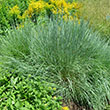
Upright clumps of slender, flat, linear bluish green leaves. Purplish-bronze blooms. Tolerates black walnut. USDA 3-9
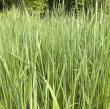
Height: 5 feet
Spread: 32 inches
Sunlight: full sun, partial shade
Hardiness Zone: 3a
Other Names: Feather Reed Grass
Description:
Dramatic red-copper plumes are eye catching during the early to mid summer months; a cool weather performer that looks wonderful in fresh or dried flower arrangements, borders or garden landscapes; heat tolerant and low maintenance
Ornamental Features:
Karl Foerster Reed Grass is primarily grown for its highly ornamental fruit. The tan seed heads are carried on showy plumes displayed in abundance from late summer to late winter. It features bold plumes of brick red flowers with coppery-bronze overtones rising above the foliage in mid summer. Its grassy leaves are green in color. The foliage often turns tan in fall. The gold stems can be quite attractive.
Landscape Attributes:
Karl Foerster Reed Grass is an herbaceous perennial grass with an upright spreading habit of growth. It brings an extremely fine and delicate texture to the garden composition and should be used to full effect.
This plant will require occasional maintenance and upkeep, and is best cut back to the ground in late winter before active growth resumes. It has no significant negative characteristics.
Karl Foerster Reed Grass is recommended for the following landscape applications:
- Vertical Accent
- Mass Planting
- General Garden Use
- Groundcover
- Naturalizing And Woodland Gardens
- Container Planting
Planting & Growing:
Karl Foerster Reed Grass will grow to be about 4 feet tall at maturity, with a spread of 32 inches. It tends to be leggy, with a typical clearance of 1 foot from the ground, and should be underplanted with lower-growing perennials. It grows at a medium rate, and under ideal conditions can be expected to live for approximately 10 years. As an herbaceous perennial, this plant will usually die back to the crown each winter, and will regrow from the base each spring. Be careful not to disturb the crown in late winter when it may not be readily seen!
This plant does best in full sun to partial shade. It is very adaptable to both dry and moist locations, and should do just fine under typical garden conditions. It is not particular as to soil type or pH. It is highly tolerant of urban pollution and will even thrive in inner city environments. This particular variety is an interspecific hybrid. It can be propagated by division; however, as a cultivated variety, be aware that it may be subject to certain restrictions or prohibitions on propagation.
Karl Foerster Reed Grass is a fine choice for the garden, but it is also a good selection for planting in outdoor pots and containers. With its upright habit of growth, it is best suited for use as a 'thriller' in the 'spiller-thriller-filler' container combination; plant it near the center of the pot, surrounded by smaller plants and those that spill over the edges. It is even sizeable enough that it can be grown alone in a suitable container. Note that when growing plants in outdoor containers and baskets, they may require more frequent waterings than they would in the yard or garden.
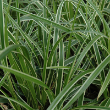
Height: 12 inches
Spread: 15 inches
Sunlight: full sun, partial shade, full shade
Hardiness Zone: 4b
Other Names: Creeping Japanese Sedge
Brand: Proven Winners
Description:
A low maintenance, cool weather ornamental grass featuring fast growing plants in the early spring and fall; beautiful narrow, arching foliage with forest green centers and creamy-white margins; well suited for containers, borders or garden beds
Ornamental Features:
Ice Dance Sedge is primarily valued in the garden for its cascading habit of growth. Its attractive grassy leaves are forest green in color with prominent white stripes. The foliage often turns brown in fall.
Landscape Attributes:
Ice Dance Sedge is an herbaceous evergreen perennial grass with a shapely form and gracefully arching stems. Its relatively fine texture sets it apart from other garden plants with less refined foliage.
This plant will require occasional maintenance and upkeep, and is best cleaned up in early spring before it resumes active growth for the season. Gardeners should be aware of the following characteristic(s) that may warrant special consideration:
- Spreading
Ice Dance Sedge is recommended for the following landscape applications:
- Mass Planting
- Border Edging
- General Garden Use
- Groundcover
- Naturalizing And Woodland Gardens
- Container Planting
Planting & Growing:
Ice Dance Sedge will grow to be about 12 inches tall at maturity, with a spread of 15 inches. Its foliage tends to remain dense right to the ground, not requiring facer plants in front. It grows at a medium rate, and under ideal conditions can be expected to live for approximately 10 years. As an evegreen perennial, this plant will typically keep its form and foliage year-round.
This plant performs well in both full sun and full shade. It prefers to grow in moist to wet soil, and will even tolerate some standing water. It is not particular as to soil type or pH. It is somewhat tolerant of urban pollution. This is a selected variety of a species not originally from North America. It can be propagated by division; however, as a cultivated variety, be aware that it may be subject to certain restrictions or prohibitions on propagation.
Ice Dance Sedge is a fine choice for the garden, but it is also a good selection for planting in outdoor pots and containers. It is often used as a 'filler' in the 'spiller-thriller-filler' container combination, providing a canvas of foliage against which the thriller plants stand out. Note that when growing plants in outdoor containers and baskets, they may require more frequent waterings than they would in the yard or garden.
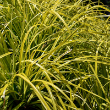
Height: 16 inches
Spread: 16 inches
Sunlight: full sun, partial shade, full shade
Hardiness Zone: 4b
Other Names: C. hachijoensis
Group/Class: EverColor Series
Description:
A vigorous, mound forming evergreen plant with striking lime green emerging foliage that matures to yellow-gold; makes quite a statement as a container plant, an accent in the border, or as a mass groundcover
Ornamental Features:
EverColor Everillo Japanese Sedge is primarily valued in the garden for its cascading habit of growth. Its attractive grassy leaves emerge lime green in spring, turning yellow in color. The foliage often turns gold in fall.
Landscape Attributes:
EverColor Everillo Japanese Sedge is an herbaceous evergreen perennial grass with a shapely form and gracefully arching stems. It brings an extremely fine and delicate texture to the garden composition and should be used to full effect.
This is a relatively low maintenance plant, and is best cleaned up in early spring before it resumes active growth for the season. It has no significant negative characteristics.
EverColor Everillo Japanese Sedge is recommended for the following landscape applications:
- Mass Planting
- Border Edging
- General Garden Use
- Groundcover
- Naturalizing And Woodland Gardens
- Container Planting
Planting & Growing:
EverColor Everillo Japanese Sedge will grow to be about 16 inches tall at maturity, with a spread of 16 inches. Its foliage tends to remain dense right to the ground, not requiring facer plants in front. It grows at a medium rate, and under ideal conditions can be expected to live for approximately 10 years. As an evegreen perennial, this plant will typically keep its form and foliage year-round.
This plant performs well in both full sun and full shade. It prefers to grow in average to moist conditions, and shouldn't be allowed to dry out. It is not particular as to soil type or pH. It is somewhat tolerant of urban pollution. Consider applying a thick mulch around the root zone in both summer and winter to conserve soil moisture and protect it in exposed locations or colder microclimates. This is a selected variety of a species not originally from North America. It can be propagated by division; however, as a cultivated variety, be aware that it may be subject to certain restrictions or prohibitions on propagation.
EverColor Everillo Japanese Sedge is a fine choice for the garden, but it is also a good selection for planting in outdoor pots and containers. It is often used as a 'filler' in the 'spiller-thriller-filler' container combination, providing a canvas of foliage against which the thriller plants stand out. Note that when growing plants in outdoor containers and baskets, they may require more frequent waterings than they would in the yard or garden.
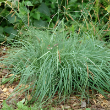
Height: 18 inches
Spread: 18 inches
Sunlight: partial shade, full shade
Hardiness Zone: 4a
Other Names: Carex glauca
Description:
A vigorous sedge that can grow in very diverse habitats; a tall, upright cultivar with attractive blue-green foliage; great in full sun or under the shade of large trees; suitable for rock gardens or as a groundcover but must have sufficient water
Ornamental Features:
Blue Zinger Blue Sedge is primarily valued in the garden for its interestingly mounded form. Its attractive grassy leaves remain bluish-green in color with showy silvery blue variegation throughout the year.
Landscape Attributes:
Blue Zinger Blue Sedge is a dense herbaceous evergreen perennial grass with a mounded form. It brings an extremely fine and delicate texture to the garden composition and should be used to full effect.
This is a relatively low maintenance plant, and is best cleaned up in early spring before it resumes active growth for the season. It has no significant negative characteristics.
Blue Zinger Blue Sedge is recommended for the following landscape applications:
- Mass Planting
- Border Edging
- General Garden Use
- Groundcover
Planting & Growing:
Blue Zinger Blue Sedge will grow to be about 18 inches tall at maturity, with a spread of 18 inches. Its foliage tends to remain dense right to the ground, not requiring facer plants in front. It grows at a slow rate, and under ideal conditions can be expected to live for approximately 10 years. As an evegreen perennial, this plant will typically keep its form and foliage year-round.
This plant does best in partial shade to shade. It is quite adaptable, prefering to grow in average to wet conditions, and will even tolerate some standing water. It is not particular as to soil type or pH. It is somewhat tolerant of urban pollution. Consider applying a thick mulch around the root zone in both summer and winter to conserve soil moisture and protect it in exposed locations or colder microclimates. This is a selected variety of a species not originally from North America. It can be propagated by division; however, as a cultivated variety, be aware that it may be subject to certain restrictions or prohibitions on propagation.
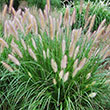
Tan bottlebrush blooms. Arching dark green foliage. Mounding. USDA 6-9
251 found, showing page 6 of 17












